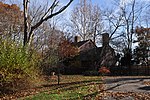Lincoln Woods State Park
1908 establishments in Rhode IslandLakes of Providence County, Rhode IslandLincoln, Rhode IslandProtected areas established in 1908Protected areas of Providence County, Rhode Island ... and 2 more
State parks of Rhode IslandUse mdy dates from August 2023

Lincoln Woods State Park is a public recreation area covering 627 acres (254 ha) around Olney Pond four miles (6.4 km) northwest of Pawtucket in the town of Lincoln, Rhode Island. The state park is known for its giant glacial boulders and the stony nature of its terrain which prevented most of the parkland from being used as farmland or for other development.
Excerpt from the Wikipedia article Lincoln Woods State Park (License: CC BY-SA 3.0, Authors, Images).Lincoln Woods State Park
Eddie Dowling Highway,
Geographical coordinates (GPS) Address External links Nearby Places Show on map
Geographical coordinates (GPS)
| Latitude | Longitude |
|---|---|
| N 41.891111111111 ° | E -71.431944444444 ° |
Address
Lincoln Woods State Park
Eddie Dowling Highway
02865
Rhode Island, United States
Open on Google Maps









